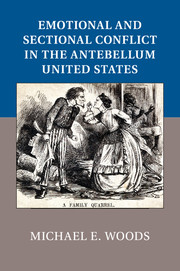'Michael E. Woods argues that emotions were critical in shaping the perceptual orientations and political action that ultimately severed antebellum America along sectional lines. Woods uncovers distinctly regional emotional regimes that structured thoughts, framed political actions, and invested local and national attachments with powerful meaning. No other scholar of this period has succeeded to the degree of Woods in showing how the act of feeling was a cultural construction, and one that had profound political consequences in forming regional identity and in leading the nation to civil war. His brilliant exploration of this subject has profound implications for how we understand Civil War America.'
Peter S. Carmichael - Gettysburg College, Pennsylvania
'Michael E. Woods analyzes the place of emotions in framing and shaping regional identities in the antebellum period in a subtle and incisive way that is nothing short of brilliant. In doing so, he mounts a powerful argument - contending that emotions played intervening, amplifying, and enabling roles rather than acting as the central independent variables responsible for the war. This book is one of the most original, sophisticated, and interpretively satisfying books on the coming of the Civil War that I have read in a long time.'
Peter A. Coclanis - University of North Carolina, Chapel Hill
‘At the heart of Michael E. Woods’s excellent new book lies the question of what unites a nation - and what dissolves one. Although antebellum politics have been well studied, Woods brings to the subject methodologies and perspectives drawn from the history of emotions, which allow him to offer a new and truly innovative interpretation. He demonstrates that differing emotional styles and norms solidified regional identities and ultimately divided the nation.’
Susan J. Matt
Source: The Journal of American History
‘Michael E. Woods is to be congratulated for this pioneering study, which brings the serious study of emotions to the history of the sectional conflict. It should set the agenda for an exciting new subfield in Civil War-era history.’
Paul Quigley
Source: The Journal of the Civil War Era
‘Reading Michael E. Woods’s remarkable examination of how emotions held together and severed the Union qualifies as a sentimental education. Readers may never have reflected on how fear, indignation, hope, contentment, resentment, anger, and love turned sectional disagreement into a national divorce. Even readers who might be hard put to explain precisely how those emotions worked, or which ones were most important; let them expect surprises!’
Mark Wahlgren Summers
Source: The American Historical Review
'Woods has written a highly original, deeply nuanced, and carefully argued emotional history of the sectional conflict. Historians of the period will recognize many of the quotations and examples cited but will find them handled with new insight. Everyone with an interest in the rise of sectionalism should read this book.'
Source: Journal of Southern History
'Woods should be commended for the breadth and depth of his research. He is explicit about his interdisciplinary influences, drawing on work from fields including psychology, sociology, and political science. Woods also cites a variety of primary sources, including letters, diaries, agricultural journals, novels, and political speeches, all to demonstrate how people in the antebellum period felt, expressed, and prescribed emotions, both individually and collectively … Emotional and Sectional Conflict in the Antebellum United States offers a significant contribution to the burgeoning field of the history of emotions, as well as a thoughtful addition to Civil War scholarship.'
Erin Austin Dwyer
Source: Journal of the Early Republic





